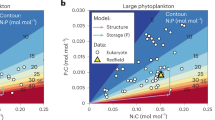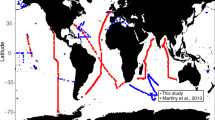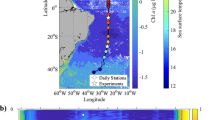Abstract
Marine phytoplankton are responsible for ∼50% of the CO2 that is fixed annually worldwide, and contribute massively to other biogeochemical cycles in the oceans1. Their contribution depends significantly on the interplay between dynamic environmental conditions and the metabolic responses that underpin resource allocation and hence biogeochemical cycling in the oceans. However, these complex environment–biome interactions have not been studied on a larger scale. Here we use a set of integrative approaches that combine metatranscriptomes, biochemical data, cellular physiology and emergent phytoplankton growth strategies in a global ecosystems model, to show that temperature significantly affects eukaryotic phytoplankton metabolism with consequences for biogeochemical cycling under global warming. In particular, the rate of protein synthesis strongly increases under high temperatures even though the numbers of ribosomes and their associated rRNAs decreases. Thus, at higher temperatures, eukaryotic phytoplankton seem to require a lower density of ribosomes to produce the required amounts of cellular protein. The reduction of phosphate-rich ribosomes2 in warmer oceans will tend to produce higher organismal nitrogen (N) to phosphate (P) ratios, in turn increasing demand for N with consequences for the marine carbon cycle due to shifts towards N-limitation. Our integrative approach suggests that temperature plays a previously unrecognized, critical role in resource allocation and marine phytoplankton stoichiometry, with implications for the biogeochemical cycles that they drive.
This is a preview of subscription content, access via your institution
Access options
Subscribe to this journal
Receive 12 print issues and online access
$209.00 per year
only $17.42 per issue
Buy this article
- Purchase on Springer Link
- Instant access to full article PDF
Prices may be subject to local taxes which are calculated during checkout




Similar content being viewed by others
References
Field, C. B., Behrenfeld, M. J., Randerson, J. T. & Falkowski, P. G. Primary production of the biosphere: Integrating terrestrial and oceanic components. Science 281, 237–240 (1998).
Elser, J. J., Fagan, W. F., Kerkhoff, A. J., Swenson, N. G. & Enquist, B. J. Biological stoichiometry of plant production: Metabolism, scaling and ecological response to global change. New Phytol. 186, 593–608 (2010).
Thomas, M. K., Kremer, C. T., Klausmeier, C. A. & Litchman, E. A global pattern of thermal adaptation in marine phytoplankton. Science 338, 1085–1088 (2012).
Falkowski, P. G., Barber, R. T. & Smetacek, V. Biogeochemical controls and feedbacks on ocean primary production. Science 281, 200–206 (1998).
Boyce, D. G., Lewis, R. M. & Worm, B. Global phytoplankton decline over the past century. Nature 466, 591–596 (2010).
Bopp, L., Aumont, O., Cadule, P., Alvain, S. & Gehlen, M. Response of diatoms distribution to global warming and potential implications: A global model study. Geophys. Res. Lett. 32, L19606 (2005).
Schlesinger, D. A. & Shuter, B. J. Patterns of growth and cell composition of freshwater algae in light-limited continuous cultures. J. Phycol. 17, 250–256 (1981).
Shuter, B. A model of physiological adaptation in unicellular algae. J. Theoret. Biol. 78, 519–552 (1979).
Weber, T. S. & Deutsch, C. Oceanic nitrogen reservoir regulated by plankton diversity and ocean circulation. Nature 489, 419–422 (2012).
Follows, M. J., Dutkiewicz, S., Grant, S. & Chisholm, S. W. Emergent biogeography of microbial communities in a model ocean. Science 315, 1843–1846 (2007).
Bruggeman, J. & Kooijman, S. A. L. M. A biodiversity-inspired approach to aquatic ecosystem modeling. Limnol. Oceanogr. 52, 1533–1544 (2007).
Clark, J. R., Lenton, T. M., Williams, H. T. P. & Daines, S. J. Environmental selection and resource allocation determine spatial patterns in picophytoplankton cell size. Limnol. Oceanogr. 58, 1008–1022 (2013).
Finn, R. D. et al. The Pfam protein families database. Nucleic Acids Res. 38 (suppl. 1), D211–D222 (2010).
Li, W. & Godzik, A. Cd-hit: A fast program for clustering and comparing large sets of protein or nucleotide sequences. Bioinformatics 22, 1658–1659 (2006).
Brady, A. & Salzberg, S. L. Phymm and PhymmBL: Metagenomic phylogenetic classification with interpolated Markov models. Nature Methods 6, 673–676 (2009).
Ashburner, M. et al. Gene Ontology: Tool for the unification of biology. Nature Genet. 25, 25–29 (2000).
Nomura, M., Grouse, R. & Baughman, G. Regulation of the synthesis of ribosomes and ribosomal components. Annu. Rev. Biochem. 53, 75–117 (1984).
Fraser, K. P. P., Clarke, A. & Peck, L. S. Low-temperature protein metabolism: Seasonal changes in protein synthesis and RNA dynamics in the Antarctic limpet Nacella concinna Strebel 1908. J. Exp. Biol. 205, 3077–3086 (2002).
Kim, K-Y. et al. Molecular cloning of low-temperature-inducible ribosomal proteins from soybean. J. Exp. Bot. 55, 1153–1155 (2004).
Mock, T. et al. Whole-genome expression profiling of the marine diatom Thalassiosira pseudonana identifies genes involved in silicon bioprocesses. Proc. Natl Acad. Sci. USA 105, 1579–1584 (2008).
Woolford, J. L. J. & Warner, J. R. in The Molecular And Cellular Biology of Yeast Saccharomyces: Genome Dynamics, Protein Synthesis And Energetics (eds Broach, J. R., Pringle, J. R. & Jones, E. W.) 587–625 (Cold Spring Harbor Laboratory Press, 1991).
Warner, J. R. The economics of ribosome biosynthesis in yeast. TIBS 24, 437–440 (1999).
Kanehisa, M. & Goto, S. KEGG: Kyoto Encyclopedia of Genes and Genomes. Nucleic Acids Res. 28, 27–30 (2000).
Martiny, A. C., Pham, C. T. A., Primeau, F. W., Vrugt, J. A., Moore, J. K., Levin, S. A. & Lomas, M. W. Strong latitudinal patterns in the elemental ratios of marine plankton and organic matter. Nature Geosci. 6, 279–283 (2013).
Reich, P. B. & Oleksyn, J. Global patterns of plant leaf N and P in relation to temperature and latitude. Proc. Natl Acad. Sci. USA 101, 11001–11006 (2004).
Doney, S. C. Oceanography: Plankton in a warmer world. Nature 444, 695–696 (2006).
Eppley, R. Temperature and phytoplankton growth in the sea. Fish. Bull. 70, 1063–1085 (1972).
Brown, J. H., Gillooly, J. F., Allen, A. P., Savage, V. M. & West, G. B. The Robert H. MacArthur Award Lecture-toward a metabolic theory of ecology. Ecology 85, 1771–1789 (2004).
Allen, A. P. & Gillooly, J. F. Towards an integration of ecological stoichiometry and the metabolic theory of ecology to better understand nutrient cycling. Ecol. Lett. 12, 369–384 (2009).
Regaudie-de-Gioux, A. & Duarte, C. M. Temperature dependence of planktonic metabolism in the ocean. Glob. Biogeochem. Cycles 26, 1–10 (2012).
Acknowledgements
Sequencing of ANT, EPAC and NPAC was funded by a Natural Environment Research Council (NERC) grant (MGF (NBAF) grant 197) and a 454 Life Sciences grant (Roche, 10Gb grant) awarded to T.M. and K.V. K.V. acknowledges the DFG for funding. Sequencing of ARC and NATL was funded by the EU FP7 project ‘Arctic Tipping Points’ awarded to G.A.P. We thank The Genome Analysis Centre (TGAC) in Norwich and Melanie Febrer for facilitating the work with 454 Life Sciences (Roche) in the US and UK. S.J.D., J.R.C. and T.M.L. acknowledge the Leverhulme Trust (F/00 204/AP) for funding. The PhD studentship of A.T. was funded by the Earth and Life Systems Alliance (ELSA) in Norwich. A.K. and T.M. acknowledge the Leverhulme Trust (F/00204/AU) for funding. Part of the bioinformatic analysis was performed on the High Performance Computing Cluster supported by the Research and Specialist Computing Support service at the University of East Anglia. We thank S. Moxon for his patient support, discussions and suggestions. We thank W. Guo and A. Marchetti for providing us with samples from EPAC and M. Parker, E. V. Armbrust, and the ‘Sorcerer II’ crew (JCVI) for assistance with sampling of NPAC. G.A.P. acknowledges A. Ramos, E. Serrão and the crew of R/V Jan Mayen, University Tromso, Norway for assistance with sampling of ARC and NATL.
Author information
Authors and Affiliations
Contributions
Metatranscriptome sample preparation: T.M., G.A.P., K.V. and C.U.; Bioinformatics: A.T. and V.M.; Western blots: A.K.; Quantitative PCR: J.S.; Growth experiments: A.K., J.S. and T.M.; Modelling: S.J.D., J.R.C., T.M.L.; T.M. designed the study and wrote the manuscript with help from S.J.D. and T.M.L. All authors discussed the results and commented on the manuscript.
Corresponding author
Ethics declarations
Competing interests
The authors declare no competing financial interests.
Supplementary information
Rights and permissions
About this article
Cite this article
Toseland, A., Daines, S., Clark, J. et al. The impact of temperature on marine phytoplankton resource allocation and metabolism. Nature Clim Change 3, 979–984 (2013). https://doi.org/10.1038/nclimate1989
Received:
Accepted:
Published:
Issue Date:
DOI: https://doi.org/10.1038/nclimate1989
This article is cited by
-
Diverse thermal responses of the growth, photosynthesis, lipid and fatty acids in the terrestrial oil-producing microalga Vischeria sp. WL1
Journal of Applied Phycology (2024)
-
Linking extreme seasonality and gene expression in Arctic marine protists
Scientific Reports (2023)
-
Ocean warming and acidification affect the transitional C:N:P ratio and macromolecular accumulation in the harmful raphidophyte Heterosigma akashiwo
Communications Biology (2023)
-
Plastic responses lead to increased neurotoxin production in the diatom Pseudo-nitzschia under ocean warming and acidification
The ISME Journal (2023)
-
Carbon, Nitrogen, and Sulfur Contents in Marine Phytoplankton Cells and Biomass Conversion
Journal of Ocean University of China (2023)



